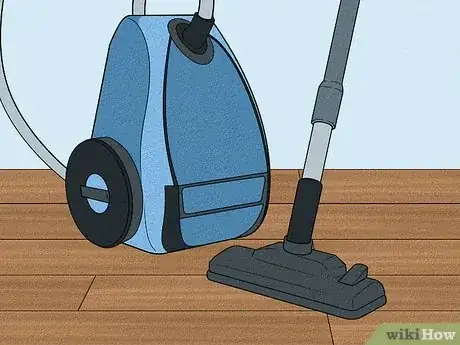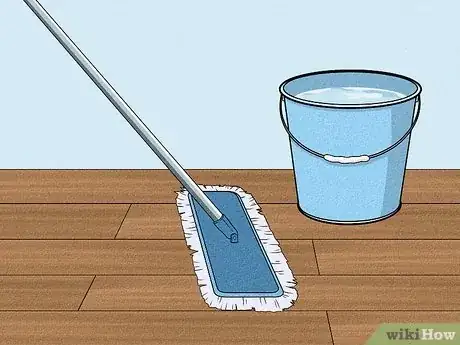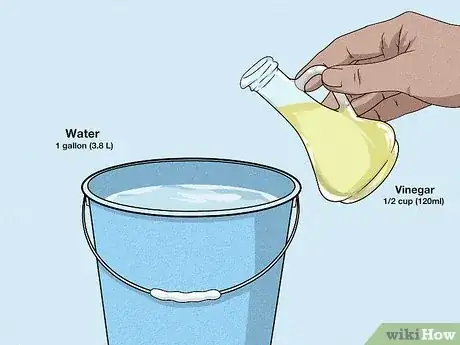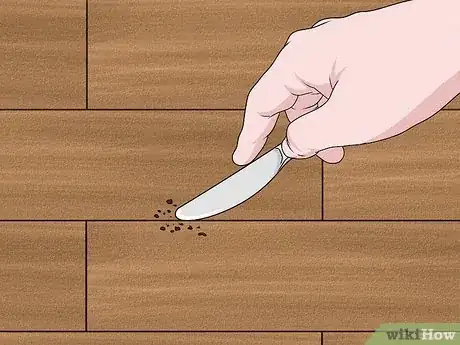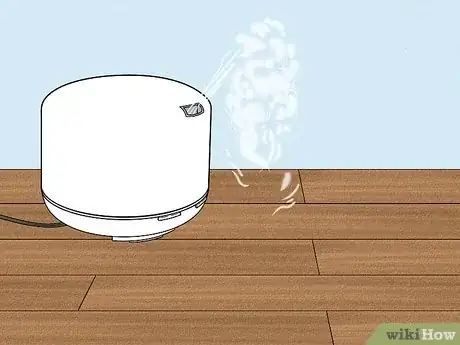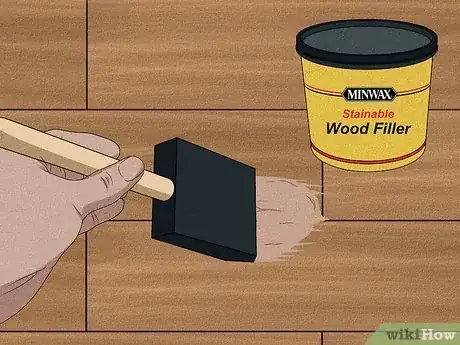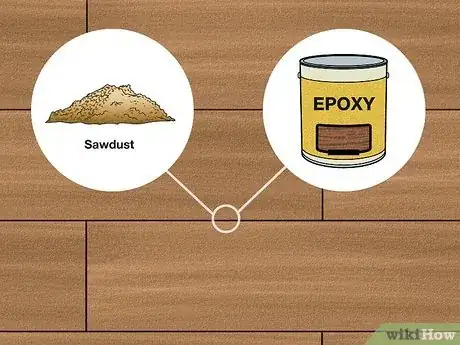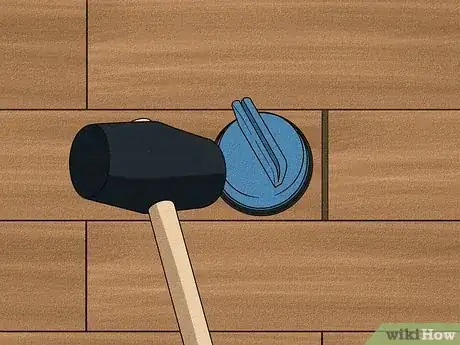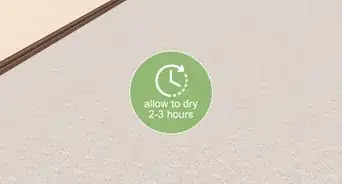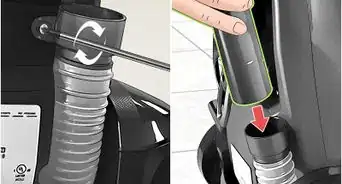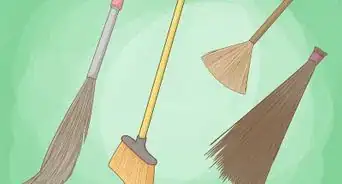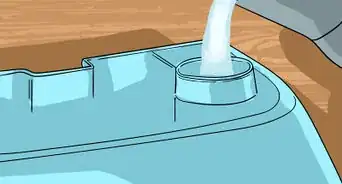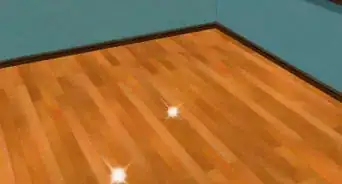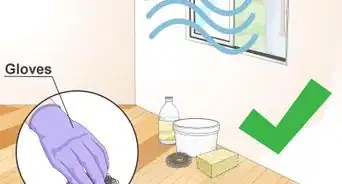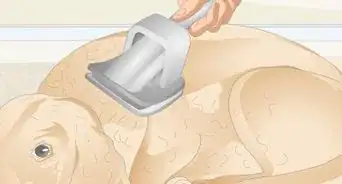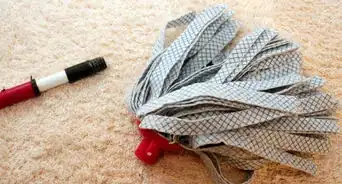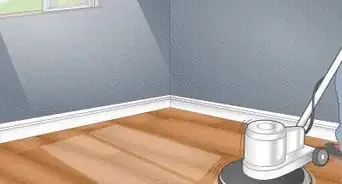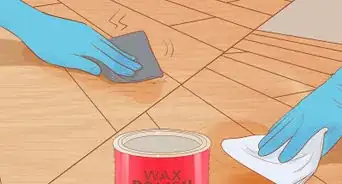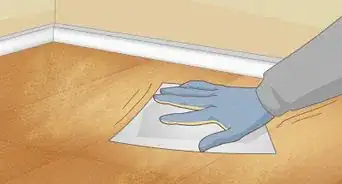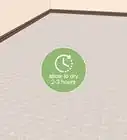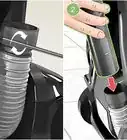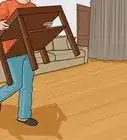This article was co-authored by Crystal Chadwick and by wikiHow staff writer, Hunter Rising. Crystal Chadwick is a Licensed General Contractor and the Owner of Yin & Yang Construction out of Salt Lake City, Utah. With over 16 years of experience in the construction industry, she specializes in remodels, repairs, and handyman services. Crystal leads her team with vision and a detail-oriented approach, allowing them to provide quality work and design to their clients.
There are 12 references cited in this article, which can be found at the bottom of the page.
This article has been viewed 4,386 times.
You love your hardwood floors, but what can you do when there’s dirt and other debris caked in the cracks between your floorboards? Luckily, it’s really easy to clean the cracks out to refresh the look of your floors, and you probably already have the tools you need. Once they’re clean, you can even fill the gaps to stop them from getting dirty. Keep reading for the best ways to clean and seal the cracks on your hardwood floors.
Things You Should Know
- Clean loose dirt between floorboards with a vacuum to suck up loose dirt. Break apart stubborn gunk with a cloth damp with water or diluted vinegar
- Scrub out any ground-in residue with a plastic putty knife.
- Clean hardwood floors weekly to keep the buildup from forming in the gaps between the boards.
- Fill in larger gaps using wood filler matching the color of your floors. You can make your own wood filler with sawdust and wood epoxy.
Steps
Cleaning Grooves Between Floorboards
-
1Use a vacuum to clean dirt and debris in the cracks. Put a floor-brush attachment on your vacuum to get into the cracks and crevices in your hardwood floor. Move your vacuum side to side over the cracks to pull up all of the loose dirt that’s stuck deep inside them.[1]
- Move your vacuum slowly across your hardwood floors so the wheels don’t scratch the surface.
- If you don’t have a hose attachment for your vacuum, switch the vacuum to the “hard floor” setting. This turns off the rotating beater bar that could scratch your hardwood.
-
2Run a damp mop over the cracks for a quick clean. Wet a sponge mop with water, but be sure to wring it out completely so it isn’t dripping wet. Mop your floors, and put in a little extra elbow grease when you’re scrubbing the grooves between the floorboards. That way, you’ll loosen and clean up some of the dirt that was still stuck in the crack.[2]
- Wipe up any big pools of water with a microfiber towel when you finish mopping since excess moisture could warp or damage the wood.
Advertisement -
3Use a white vinegar solution to break apart grime. Dilute 1⁄2 cup (120 ml) of white vinegar in 1 gallon (3.8 L) of water, and stir it until it’s thoroughly mixed. Wet a microfiber towel in the mixture and wring it out completely. Try scrubbing the cracks in your floorboards to get rid of the gunk that’s stuck between them.[3]
- Try using a soft-bristled toothbrush to gently break apart the stuck-on debris on the surface.
-
4Scrape gunk out of the cracks with a plastic putty knife. Position the corner of your putty knife into the crack between the boards. Gently move the putty knife back and forth along the crack to break apart the debris that’s caked inside. Then, run your vacuum over your floor to clean up the dirt you loosened up.[4]
- You could use a plastic butter knife in a pinch if you don’t have a putty knife.
-
5Clean your hardwood floors weekly to prevent buildup. Carve out a few minutes each week to run a dust mop or vacuum through the room, focusing on the cracks between the floorboards. Make sure you spot-clean any spills as soon as you notice them to keep your floors protected.[5]
- Twice a year, deep-clean your floors by mopping them with a solution of 1⁄4 cup (59 ml) of dish soap and 1 gallon (3.8 L) of warm water.
Fixing Gaps in Hardwood Floors
-
1Run a humidifier when there’s dry weather. When there’s less moisture in the air, floorboards shrink and leave gaps between them. Use a humidifier in the room with your hardwood floors to help restore their moisture and return the boards back to their normal size.[6]
- It’s normal for gaps in your floorboard to be about the same thickness as a dime. If the cracks are any wider, then you should fill them.[7]
-
2Apply a wood filler to the gaps to completely fill them in. Get a wood filler that matches the color of your floors and will expand and shrink with your floorboards. Put blue painter's tape along the edges of the gaps to protect your flooring. Fill the gaps in your wood floors using a putty knife and let the filler harden completely. After that, go over the filler with fine sandpaper to level it out. When you’re finished, just remove the tape.[8]
- Filling in all the gaps in your flooring could take a day to finish completely, so it works best for small rooms.
- Apply the wood filler to your floor in sections starting in the far corner of your room and working towards the entrance.
- Wait until humid weather to fill in cracks in your hardwood floors. Doing it during dry weather could cause the wood filler to break and pop out when the wood swells again.
-
3Try filling small cracks with a mixture of sawdust and epoxy. Put painter's tape along the edges of the gaps so you don’t get any epoxy on your hardwood. Make a thick sawdust paste by mixing it with the epoxy. Use a putty knife to push the sawdust and epoxy into the grooves of your floor. Work quickly since the epoxy will get harder to work with the longer it sits. Give the epoxy a few hours to set before sanding it level with the floors. Then, just remove the tape to finish your floors.[9]
- To match the color of your floor, stir a few drops of wood stain into the sawdust and epoxy before you apply it. Otherwise, wait until the epoxy hardens to stain your entire floor.
- It may take a full day to completely fill in the gaps in your floor with sawdust and epoxy.
-
4Fill grooves between wide-plank floors with natural-fiber rope. Choose a length of rope that has the same thickness as the crack in your hardwood floor. Line the rope up with the gap and push it into the crack using a putty knife. Keep pushing the rope into the gap along its entire length, and cut the end with scissors or a utility knife.[10]
- Adding rope between your floorboards adds a more rustic look and keeps dirt and debris from getting trapped deeper.
- If you want it to blend in with your floorboards, stain or dye the rope before you install it. Just put the rope in a bucket and submerge it in your wood stain or dye until it turns the desired color. Let it dry completely before you use it.
-
5Tap the ends of laminate boards together with a mallet and suction cup tool. If the gaps are between the ends of 2 floorboards, secure the suction cup tool onto one of the boards. Tap the side of the suction cup tool with your mallet to push the floorboards closer together so they seal the gap.[11]
- This works best for floating hardwood floors and not if the floorboards are nailed down.
- Unfortunately, using a suction cup will not work for gaps between the sides of hardwood floorboards.
- Avoid using a standard plastic suction cup since it won’t stay attached when you tap it with a mallet.
Warnings
- Avoid using any steam cleaners on your hardwood floors since the moisture could damage or warp the wood.[13]⧼thumbs_response⧽
Things You’ll Need
Cleaning Grooves Between Floorboards
- Vacuum
- Sponge mop
- White vinegar
- Microfiber cloth
- Plastic putty knife
Fixing Gaps in Hardwood Floors
References
- ↑ https://www.cleanipedia.com/au/floor-and-surface-cleaning/flooring-how-to-clean-hardwood-floors.html
- ↑ https://www.cleanipedia.com/gb/floor-and-surface-cleaning/clean-wooden-floors.html
- ↑ https://www.bobvila.com/articles/best-way-to-clean-hardwood-floors/
- ↑ https://youtu.be/7focJeab0pM?t=9
- ↑ https://www.bobvila.com/articles/best-way-to-clean-hardwood-floors/
- ↑ https://classicwoodfloors.com/wp-content/uploads/2018/08/NOFMA_FloorCareGuide_Web.pdf
- ↑ https://youtu.be/ykXaEmkALNc?t=147
- ↑ https://www.bobvila.com/articles/how-to-fix-scratches-on-hardwood-floors/
- ↑ https://youtu.be/uogQOcKpnE0?t=174
